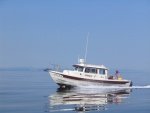marco422
New member
- Joined
- Sep 25, 2008
- Messages
- 103
- Reaction score
- 0
- C Dory Year
- 2007
- C Dory Model
- 16 Cruiser
- Vessel Name
- Gaiasika
When I was out of Tofino last summer on my way to Hot Springs Cove I was dealing with 6-8 foot swells among the rocks off Vargas Island. I have a single Honda 50 with no kicker and wondered how the boat would act if the engine failed. I have let the boat lie in open water, but not in steeper seas.
Does anyone have insight into what happens when C-Dorys float without power in seas/swells. I suspect they would settle beam-on to seas without a drogue. At what point would this become dangerous in terms of swell height and period if the weight was fairly low down in the boat? Any experiences?
Does anyone have insight into what happens when C-Dorys float without power in seas/swells. I suspect they would settle beam-on to seas without a drogue. At what point would this become dangerous in terms of swell height and period if the weight was fairly low down in the boat? Any experiences?

